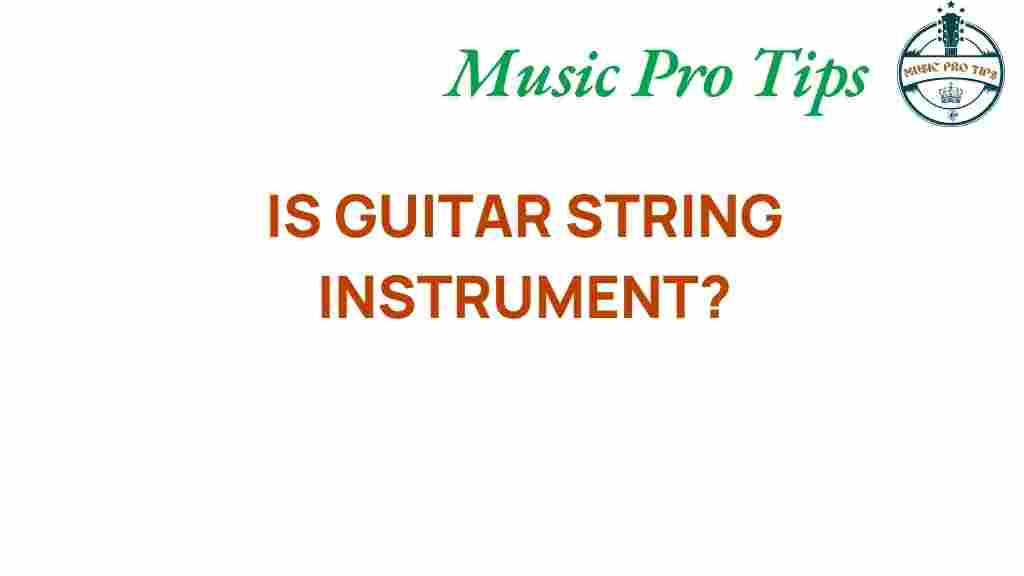Unraveling the Mystery: Is a Guitar Truly a String Instrument?
The guitar, a beloved musical instrument, has long been a cornerstone of various music genres, from folk and blues to rock and classical. But what exactly qualifies it as a string instrument? In this article, we will delve into the intricacies of the guitar’s classification, explore its acoustic and electric forms, and understand its role in music theory and musical history. By breaking down its sound production and acoustic properties, we aim to answer the question: is a guitar truly a string instrument?
The Classification of the Guitar as a String Instrument
The classification of musical instruments is a nuanced subject that can sometimes lead to confusion. Instruments are typically classified into families based on their sound production methods. The guitar fits squarely into the string instrument category, and here’s why:
- String Vibration: The guitar produces sound primarily through the vibration of its strings. When a string is plucked or strummed, it vibrates, creating sound waves that resonate within the instrument’s body.
- Types of Strings: Guitars can feature nylon strings (common in classical guitars) or metal strings (typically found in acoustic and electric guitars), both of which contribute to its classification as a string instrument.
- Sound Production Mechanism: The guitar’s sound production involves either acoustic resonance or electromagnetic induction, depending on whether it is an acoustic or electric guitar.
The Guitar in Music Theory
Understanding how the guitar fits into music theory is crucial for musicians and enthusiasts alike. Here are several key points:
- Chord Construction: Guitars are widely used for chordal harmony, allowing players to create complex harmonic structures through simple finger placements.
- Scales and Modes: Guitarists often utilize scales and modes to improvise and compose, making the instrument a versatile tool for musical expression.
- Notation: The guitar uses standard notation and tablature, which helps players understand musical concepts and play various pieces effectively.
Acoustic vs. Electric Guitars
The distinction between acoustic and electric guitars is essential when discussing their sound production and acoustic properties:
- Acoustic Guitars: These instruments rely solely on acoustic sound production. The body of the guitar amplifies the sound produced by the vibrating strings. The quality of wood and body shape greatly affects the tone and volume.
- Electric Guitars: Electric guitars use pickups to convert string vibrations into electrical signals, which are then amplified. This allows for a wider range of sounds and effects, making them popular in various music genres.
Exploring the Acoustic Properties of the Guitar
The acoustic properties of a guitar play a significant role in its classification as a string instrument. These properties include:
- Resonance: The body of an acoustic guitar resonates with the sound waves produced by the strings, enhancing the overall sound quality.
- Tonewoods: Different types of wood used in the construction of guitars (like spruce, mahogany, and maple) contribute to the unique tonal characteristics of each instrument.
- Shape and Size: The design of the guitar body influences its sound projection and tonal balance, with various shapes like dreadnought, concert, and parlor offering distinct sounds.
Musical History of the Guitar
The guitar has a rich musical history that traces back several centuries. Understanding this history helps contextualize its significance as a string instrument:
- Origins: The guitar’s ancestors can be found in ancient string instruments such as the lute and the vihuela, which laid the groundwork for modern guitars.
- Evolution: Over time, the guitar evolved into various forms, leading to the development of both the acoustic and electric guitar in the 20th century.
- Influence on Music: The guitar has influenced countless genres of music, shaping everything from classical compositions to contemporary rock and pop.
Step-by-Step: Understanding Guitar Sound Production
To truly appreciate how a guitar functions as a string instrument, it’s essential to understand its sound production process:
- String Plucking: When a guitarist plucks or strums the strings, they create vibrations.
- Vibration Transfer: These vibrations travel along the strings and resonate through the guitar body.
- Sound Amplification: In acoustic guitars, the hollow body amplifies the sound. In electric guitars, pickups convert string vibrations into electrical signals.
- Sound Output: The amplified sound is then projected through the guitar’s sound hole or through an amplifier for electric guitars.
Troubleshooting Guitar Sound Production Issues
Sometimes, guitarists may encounter issues with sound production. Here are some troubleshooting tips:
- Check the Strings: Ensure that the strings are properly tuned and in good condition. Old or worn strings can result in dull sound quality.
- Inspect the Guitar Body: Look for cracks or damage to the guitar body, which can affect resonance and sound quality.
- Amplifier Settings: For electric guitars, verify that the amplifier settings are appropriately adjusted to achieve the desired sound.
Conclusion: The Guitar as a String Instrument
In conclusion, the guitar is unequivocally classified as a string instrument based on its sound production methods, acoustic properties, and historical significance. Whether one plays an acoustic guitar or an electric guitar, the fundamental principles of string vibration and resonance remain the same. By understanding its role in music theory and its evolution throughout musical history, we can better appreciate the guitar’s impact on music and its rightful place in the pantheon of string instruments.
For more information on musical instruments and their classifications, check out this comprehensive guide. If you’re looking to explore the world of guitar further, visit this resource for tips on playing techniques and styles.
This article is in the category Theory and created by MusicProTips Team
